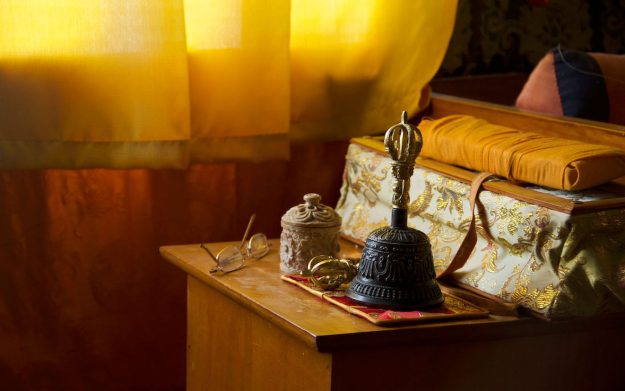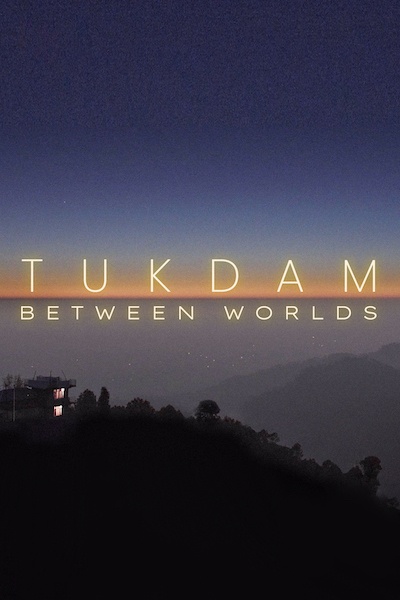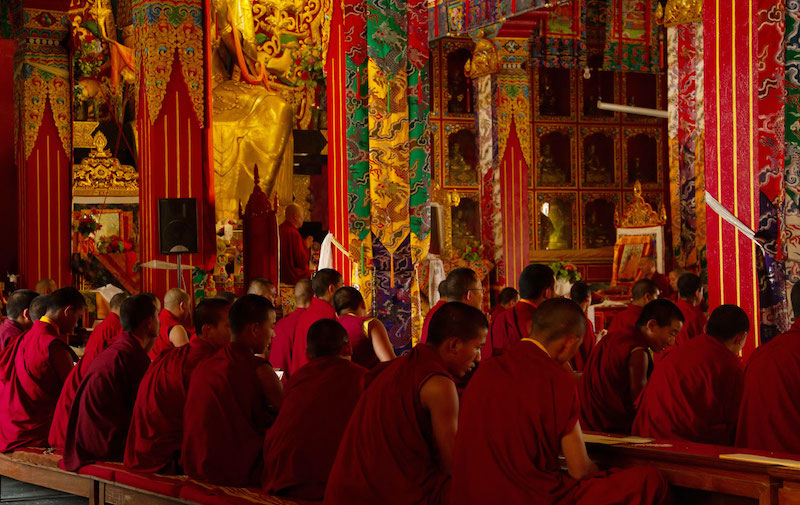“Victorians denied sex; our modern youth-obsessed culture rejects death. Failing to face up to this basic fact of life results in great fear and suffering. Tukdam: Between Worlds shines a light on this inescapable part of life and gives occasion to reflect on what a good death might be.” —Donagh Coleman
Death awaits us all. And what happens to our consciousness at the time of death continues to captivate people’s imagination. In Tukdam: Between Worlds, a new film by Finnish-Irish-American filmmaker Donagh Coleman (available for streaming), we get a glimpse into a contemporary exploration of death and dying through renowned neuroscientist Richard Davidson and his team’s investigation into the Tibetan Buddhist phenomenon of tukdam (var. thukdam). Blurring the line separating life and death, this documentary provides a rich discussion in its search to understand one of life’s great mysteries.
Tukdam means to hold or bind (dam) the mind (tug). In this advanced state of meditation, the practitioner’s consciousness remains in a state of awareness or deep meditation focused at the heart center. In Himalayan Buddhist traditions, those who practice tukdam at the time of death are reportedly able to slow down the decomposition of their body and remain in this meditative state. Practitioners who achieve this consciously controlled death reportedly display certain characteristics: the body remains fresh for days and even weeks after death; there is no rotting scent of decomposition; the skin remains supple; a warmth around the heart area remains, even though there is no heartbeat; and the body often remains upright in a meditative posture. Tibetan Buddhists consider this an advanced meditative state of “mind over matter,” and such control of consciousness during dying can reportedly lead to full awakening, or, at least, to a positive reincarnation.
Tibetan Buddhist masters have long studied the process by which consciousness leaves the body and have transmitted those teachings for centuries. Not considered a magical or miraculous event, the practice of tukdam requires discipline, training, effort, and the right motivation. When master meditators fully realize this practice, they can also help lead others out of suffering and ignorance. These rituals and practices are an integral part of Tibetan culture and beliefs.

Tukdam: Between Worlds provides an accessible introduction to this death practice, focusing on real-life cases and the scientists investigating them. Including interviews with His Holiness the 14th Dalai Lama, American scientists, embalmers, and Tibetan doctors with backgrounds in both Buddhism and Tibetan medicine, this documentary juxtaposes the Western scientific quest to understand tukdam with Buddhist understandings of the continuity of consciousness and reincarnation. Coleman, a follower of Tibetan Buddhism and currently pursuing a PhD in medical anthropology at UC Berkeley, expertly weaves together both scientific and human stories into a narrative of differing viewpoints on death, the limits of scientific investigations, and the extraordinary, and often mysterious, qualities and capabilities of the mind.
Although sympathetic toward Buddhism and friends of the Dalai Lama, Davidson and his team of scientists clearly want to examine tukdam through Western scientific methods. Highlighting the tension (but also confounding agreement) between the scientific and Buddhist approaches to consciousness, one of the Tibetan doctors in the documentary points out the futility of trying to pinpoint consciousness through physical characteristics and brain activity alone, exercises he sees as illustrating the limits of their Western scientific understanding and approaches. Despite the team’s best efforts to scientifically measure why these physically dead bodies were not decaying, the results were inconclusive. Acknowledging that the phenomenon is rare and unusual, they are continuing their investigations.
Having recently experienced the unexpected death of someone close to me, this documentary struck an emotional chord through its reminder of the fragility of life. As a practitioner who has received the empowerment and transmission of the Tibetan Buddhist practice of phowa, another form of conscious dying, I understand the difficulty of such practices. If the mind is not prepared or trained for the moment of death, then controlling the death process and guiding the consciousness to a good rebirth will be difficult, if not impossible. And that training requires real discipline, effort, and motivation. Tukdam: Between Worlds does not explain the intensive training process required, but it successfully reveals the mental and physical possibilities during death. In that respect, it was both an inspiring and moving film.
After a screening at the Dharamshala International Film Festival on November 6, 2022, Coleman shared his motivations for making the documentary. Having made other films about Tibetan culture, in 2012, while visiting a Tibetan monastery in India, he heard reports of a well-known Tibetan lama in Nepal in a state of tukdam that piqued his interest. He started interviewing some monks at the monastery about the phenomenon, which eventually led to the creation of the documentary.
During the Q&A session, a participant asked Coleman why he presents only one example of a female tukdam and why the documentary lacks the voices of female practitioners. Coleman acknowledged the existence of other recorded examples of female tukdam, but said they were unable to gain access to them, despite trying, and thus could not include them in the film. When I later pressed this question in person, Coleman revealed that he interviewed the well-known British Tibetan Buddhist nun Jetsunma Tenzin Palmo, but did not include the conversation due to time and narrative constraints. (I requested that he consider releasing the footage in the future.)
Like searching for the jewel hidden in the mud, the journey to discover our true mind sometimes requires a leap of faith—a confidence that the jewel is indeed waiting to be revealed. Similarly, our perception of life and death depends on how we choose to perceive them. Although the scientists in Tukdam: Between Worlds did not come to any final conclusions about why the bodies stay in such a good state, by looking closely at the practices and beliefs around tukdam, they demonstrate a sentiment attributed to Helen Keller, that the best and most beautiful things in the world cannot be seen or even touched, but must be felt in the heart.

Thank you for subscribing to Tricycle! As a nonprofit, we depend on readers like you to keep Buddhist teachings and practices widely available.
